Introduction: Discourse Functions in the Language Classroom
Language classrooms, as social environments, provide teachers and learners with opportunities to utilise discourse functions which are essential to communicate. When learners exert control on discourse functions, it is claimed that it determines the quality of their discourse (Ellis, 2012), and the development of discourse competence that is transferable to natural situations (Long & Porter, 1985). However, learners’ opportunities to utilise a wide range of discourse functions during teacher-led interactions have been found to be limited (Ellis, 2012). Due to teachers’ and learners’ unequal interactional roles and teachers’ dominance over classroom discourse, discourse functions are claimed to be normally the “teachers’ exclusive preserve” (Long & Porter, 1985, p.207). Because of the shift from teacher- to learner-centred teaching and a movement towards learner autonomy in the last two decades (see Kumaravadivelu, 2001; Walsh, 2013), language teachers have been widely criticised for limiting learners’ opportunities not only to interact (Consolo, 2006; Walsh, 2006), but also to use discourse functions which allow them to develop speaking skills (Long et al., 1985). Learners utilising a low number of discourse functions can be explained by teachers’ pressure to advance the lesson; a reliance on textbooks, tasks, and drills; an emphasis on grammatical and phonological accuracy; and learners’ inhibition to speak in public (Long et al., 1976). Ellis (2012) contends that learners’ limited discourse functions are also a consequence of a reliance on initiation/response/feedback (IRF) patterns which hinders them from: 1) taking up varied discourse functions, 2) benefitting from greater discourse creativity (Long et al., 1976), and 3) developing discourse competence (Long et al., 1976).
The unequal interactional roles of teachers and learners are thought to prevail in foreign language (FL) classrooms (Karaata, 2011), which research literature has found to be most learners’ main opportunity to practise the target language (Dinçer & Yeşilyurt, 2013; Velázquez & García Ponce, 2016; Yoshida, 2013). However, despite the fact that research discourse was formulated in the 1970s and 1980s on learners’ use of discourse functions (see, for example, Cathcart, 1986; House, 1986; Long et al., 1976; Long & Porter, 1985), it is still not clear the extent to which communication in FL classrooms is conducive to promoting the use of a range of discourse functions because language research has been mostly conducted in second language classrooms (Philp & Tognini, 2009), leaving the discourse constructed by teachers and learners in FL classrooms considerably unexplored (Medgyes, 2000). This evidence raises the need to explore learners’ opportunities to use discourse functions and thus develop discourse competence during FL interactions.
The Aim of Study
The primary aim of this study is to explore the extent to which English as a foreign language (EFL) interactions provided learners with opportunities to use discourse functions and thus develop discourse competence. In order to develop this understanding, the study examines the incidence and range of discourse functions initiated by learners during teacher- and peer-led interactions for speaking practice at three proficiency levels (please, refer to Table 1 for information about these English courses). The study is guided by three research questions (RQs), as shown below.
RQ 1: What is the incidence of learners’ discourse functions in teacher- and peer-led interactions at the three proficiency levels?
RQ 2: What kind of (teacher- or peer-led) interaction promotes the widest range of discourse functions?
RQ 3: What pedagogical implications can be learned from RQs 1 and 2 in order to promote learners’ use of discourse functions?
Research Setting
The study is part of a larger research project which was conducted to investigate several aspects of classroom interactions between EFL teachers and learners on a BA in Languages programme in a Mexican university. The explorations of the learners’ discourse functions were conducted in three English courses: English I (basic level), English V (intermediate level), and English IX (advanced level). The following table summarises general information about these courses:

Table 1.Descriptions of the English courses (UAEM, 2010).
As shown in Table 1, English at basic and intermediate levels are offered as credit-bearing units; the advanced level is studied as an optional unit which carries no credit. After semester III (the second half of Year 2), learners are required to choose two majors: English or French, and language teaching or translation studies. Therefore, all the participant learners at the intermediate and advanced levels were majoring in English, and most of them were trained to become language teachers.
Courses at basic and intermediate levels involve six hours of English study per week, where three hours are centred on learning the language form (theory) and other three on practising the language. In English courses at advanced levels, learners study the language form for two hours per week, and practise the language for three hours per week. According to the curriculum (UAEM, 2010), the argument that lies behind the decision to reduce the number of hours after semester VI (Year 3) is that learners will study the language independently as part of a self-learning programme encouraged by the university (UAEM, 2010). However, a large number of learners in this context do not comply with this stipulation, and mostly practise the FL in the classroom (Velázquez & García Ponce, 2016).
Participants
In total, 63 learners participated (17 at the basic level; 26 at the intermediate level; and 20 at the advanced level). They were originally from Mexico, their age ranged from 18-24 years old, and they shared Spanish as an L1. The majority of the learners had educational backgrounds from state schools, where exposure to the language is normally five hours per week in classrooms of approximately 30-40 learners. Other learners, though not many, came from private schools where exposure to English ranges from 15 to 20 hours per week. The participant teachers were female, originally from Mexico, and spoke Spanish as a mother tongue. They all stated that they had been learning English as an FL for 14 or more years, and teaching it for seven or more years.
Collecting and Processing the Interactional Data
At each proficiency level, the recorded classroom interactions were carried out in two sessions of two hours each (100 minutes approximately), following the claim that they can provide a detailed and comprehensive descriptionof participants’ interactional behaviour (Larsen-Freeman & Long, 1991). In line with the suggestion that research should be conducted in uncontrolled classrooms (Foster, 1998; Kumaravadivelu, 2001), the teachers’ teaching style, structure of the class, number of learners, and time were not modified during the interactional data collection. Specifically, the tasks were not designed, nor selected for investigating the learners’ discourse functions. The argument that lies behind this decision is that teaching and learning practices, at least in this educational context, mostly relied on the activities proposed in textbooks. Thus, the imposition or modification of tasks to explore discourse functions would not reflect the tasks and interactions that are commonly performed by the teachers and learners in this teaching context. In total, 600 minutes of classroom interactions were recorded, and transcribed in their entirety.
For analysis purposes, the transcribed data was segmented into teacher-led interactions (TLIs), defined as discussions led by teachers which serve the purpose of practising speaking, and peer-led interactions (PLIs), described as interactional discourse constructed by learners in pairs or, in a few instances, in trios to practise speaking. As shown in Appendices 1 and 2, the classes comprised interactions that focused on meaning and others that focused on form. That is, interactions requiring learners to use language communicatively with an emphasis on meaning and to attain an objective, were classified as following a focus on meaning, whereas interactions during which learners practised specific (grammar or vocabulary) forms were classified as following a focus on form. Moreover, the interactions served different purposes, requiring learners to:
- practise vocabulary (TLIs 2-4 and PLIs 4-6 at the basic level; TLI 1 at the intermediate level; TLIs 1 and 2 at the advanced level)
- negotiate choices (PLIs 1-3 at the advanced level)
- describe pictures (TLI 4 and PI 1 at the basic level)
- discuss personal information (TLI 5 and PI 2 at the basic level; 6 at the advanced level)
- talk about experiences, opinions, and perceptions (TLIs 2-4 and PLIs 1-6 at the intermediate level; PLIs 4 and 5 at the advanced level)
All the participants were informed of their right to withdraw at any time, and they gave their consent to participate. Complying with their right to be anonymised and protected, the learners’ names and identities were carefully anonymised in the data. Instead, abbreviations and pseudonyms are used. The word ‘Learner’ or the letter ‘L’ and an identification number (e.g., L21) are used to refer to specific learners in the extracts, results and discussion.
Coding the Discourse Functions
Seventeen discourse functions were selected and coded for analysis purposes. The following table summarises the discourse functions, their specifications, and supporting examples:

Table 2.Seventeen discourse functions.
As shown in Table 2, 17 discourse functions were coded for analysis. These discourse functions were taken and adapted from Long et al.’s (1976) Embryonic Category System (ECS). From 44 categories that they list, 17 discourse functions were chosen as relevant for examining the learners’ discourse performance across the different activity types at the three proficiency levels. It is acknowledged that these discourse functions are not conclusive; the total number is far more extensive.
As noted by Walsh (2011), teachers’ and learners’ utterances sometimes include more than one discourse function, as illustrated below.
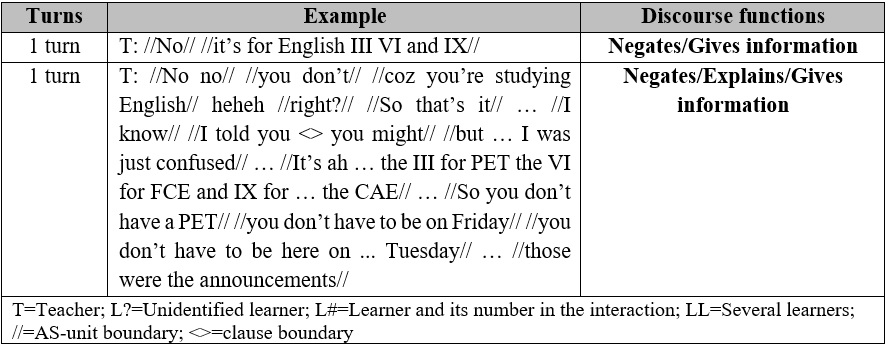
Figure 1.Complex turns in terms of discourse functions.
As shown in Figure 1, the two teachers’ turns are complex in terms of discourse functions. That is, more than one discourse function is simultaneously performed in each turn, one after the other. This was also acknowledged by Long et al. (1976), who maintain that more than one discourse function within a turn can occur in ‘free-flowing talk’. Consequently, the identification of discourse functions in the interactional data was facilitated by having segmented the teachers’ and learners’ turns into AS-units, since meaning as well as discourse functions can be isolated in AS-units (see Foster, Tonkyn & Wigglesworth, 2000, for more information about the AS-unit and applications). The following table shows the specifications of AS-units and examples of how they were segmented.
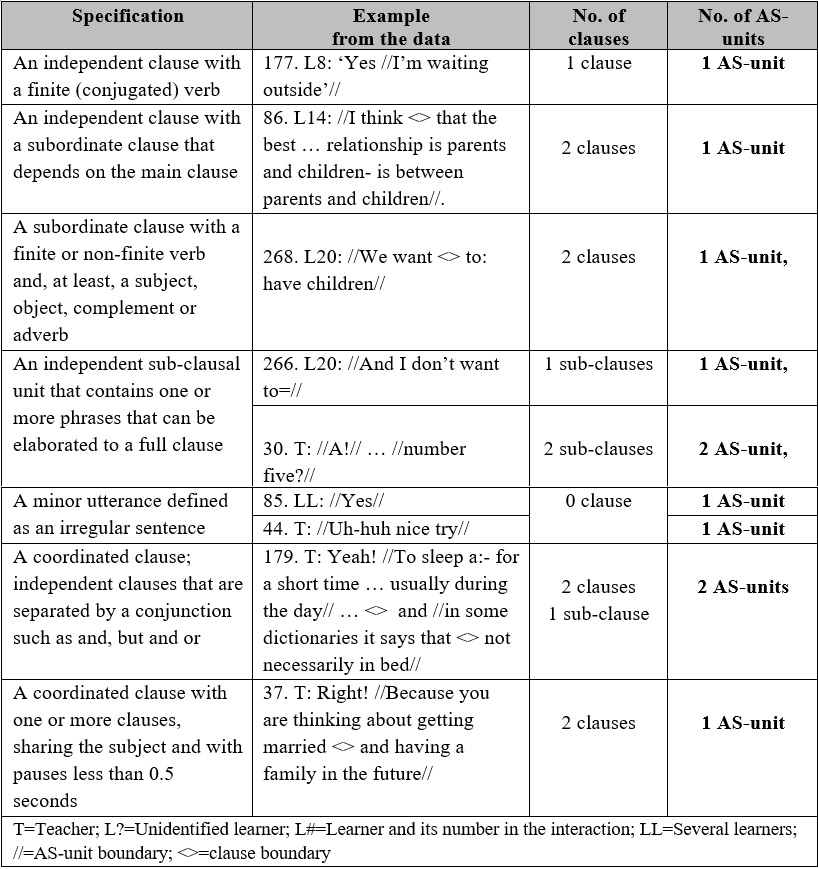
Table 3.The AS-unit and specifications.
After segmenting the interactional data into AS-units and identifying the discourse functions in the TLIs and PLIs, the learners’ discourse functions were classified into their respective category and tallied. In order to explore the proportion of the teachers’ and learners’ use of discourse functions during the whole recorded sessions, percentages of the total number of the teachers’ and learners’ discourse functions were calculated as follows.
.jpg)
The total number of the teachers’ or learners’ discourse functions was firstly divided by the total number of discourse functions in the (whole recorded) interaction, and then multiplying the result by 100. Moreover, in order to explore the extent to which the learners utilised discourse functions in the TLIs and PLIs, percentages are calculated as follows.

The total number of each discourse function initiated by the learners is firstly divided by the total number of learners’ discourse functions in each kind of interaction (TLI or PLI) and then multiplying the result by 100.
Results and Discussion
In addressing RQ 1 (i.e., what is the incidence of learners’ discourse functions in teacher- and peer-led interactions at the three proficiency levels?) and RQ 2 (i.e., what kind of (teacher- and peer-led) interaction promotes the widest range of discourse functions?), Section 3 explores the incidence and range of discourse functions initiated by the learners during the whole recorded sessions, TLIs, and PLIs. In previous empirical studies, teachers’ dominance of discourse functions has been long documented (see, for example, Long et al., 1976; Long & Porter, 1985). As shown in Table 4, this dominance was not the exception during the whole recorded sessions at the three proficiency levels.

Table 4. Total number of discourse functions at the three proficiency levels.
It is apparent from this table that the three teachers dominated the number of discourse functions at the three proficiency levels (ranging from 61.3% to 84.8%). In contrast, the learners utilised a lower number of discourse functions than the teachers (from 15.1% to 38.6%). These results can be explained by the teachers’ dominance over classroom talk and a reliance on display questions which limited the learners’ opportunities to contribute to the discourse and thus utilise a range of discourse functions. It should be noted that the intermediate learners used the highest number of discourse functions across proficiency levels (a percentage of 38.6% compared to 26.2 % at the basic level and 15.1% at the advanced level). At the end of this section, I will discuss and provide evidence which may explain the intermediate learners’ greater use of discourse functions than the basic and advanced learners.
The tables below summarise the discourse functions that the learners initiated during the TLIs and PLIs at the three proficiency levels. For practicality reasons, the discourse functions that were not initiated during the interactions are omitted in the tables. The following two tables outline the learners’ discourse functions in the TLIs and PLIs at the basic level:

Table 5. Discourse functions in the TLIs (basic level).
Table 5 shows that the basic learners utilised a range of seven discourse functions in the TLIs. In particular, the learners mostly utilised the discourse functions provides an example (an average of 12.4 per TLI), explains or gives information (an average of 7.8 per TLI), and confirms (an average of 1.4 per TLI). Interestingly, the PLIs are found to provide the learners with opportunities to utilise a greater number and range of discourse functions than the TLIs, as detailed in Table 6.

Table 6. Discourse functions in the PLIs (basic level).
The results indicate that the learners initiated ten different discourse functions during the PLIs. Across the PLI data, the most frequent discourse functions were provides an example (an average of 20.5 per PLI), explains or gives information (an average of 17.16 per PLI), andextends a previous contribution (an average of 10 per PLI). In comparing the basic learners’ discourse functions during the TLIs and PLIs, the tables reveal that the learners’ turns in the PLIs involved not only a greater number, but also a greater range of discourse functions than in the TLIs. This can be explained by the absence of the teacher’s dominance over the discourse during the PLIs which handed greater responsibility for the discourse over to the learners. This responsibility, defined as an agentive interactional role of learners, involved a greater range of learners’ interactional and discourse moves, which had an impact on the learners’ use of discourse functions (at the end of this section, I provide some interactional evidence which suggests that this was the case across the PLIs). In observing whether the focus (meaning or form) of the interactions had an impact on the number and range of learners’ discourse functions at the basic level, the tables show that there is a trend towards a greater number of explains or gives information functions in the meaning-focused TLIs and PLIs. In the form-focused TLIs and PLIs, the learners tended to utilise provides an example functions.
A similar pattern is found in Tables 7 and 8 which outline the learners’ discourse functions at the intermediate level.

Table 7. Discourse functions in the TLIs (intermediate level).
As in the TLIs at the basic level, the results indicate that learners’ turns involved a range of seven discourse functions in the TLIs. It is apparent that the learners’ dominant discourse functions were explains or gives information (an average of 20 per TLI) and provides an example (an average of 11 per TLI). It should be noted that the number of discourse functions in the TLIs at the intermediate level is higher than the TLIs at the basic and advanced levels (an average of total number of discourse functions of 47.7 per TLI at the intermediate level compared to an average of 25.2 per TLI at the basic level and 16.5 per TLI at the advanced level). Similar to the basic level, the learners’ turns involved a greater number and range of discourse functions in the PLIs than in the TLIs, as shown in Table 8.
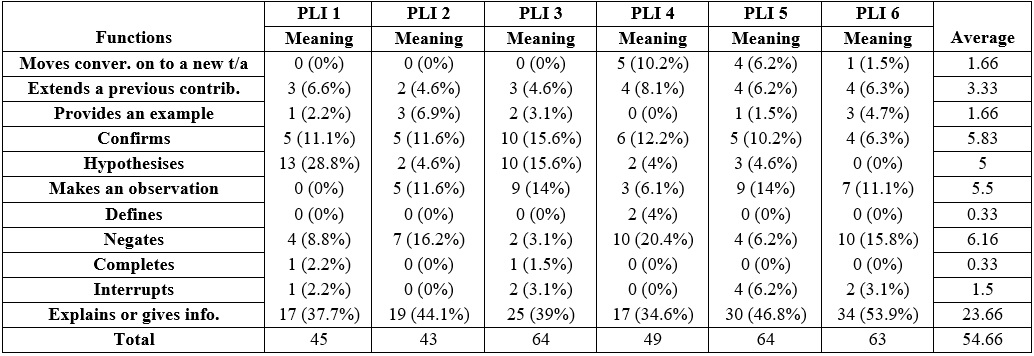
Table 9. Discourse functions in the TLIs (advanced level).
Table 9 shows that the learners utilised a range of seven discourse functions in the two TLIs at the advanced level. The most frequent discourse functions that the learners initiated were provides an example (an average of 2.5 per TLI), negates (an average of 2.5 per TLI) and confirms (an average of 2.5 per TLI). Across proficiency levels, the advanced learners’ turns in the TLIs involved the lowest number of discourse functions. As previously discussed, this low incidence of discourse functions can be explained by a focus on form of these TLIs which required the learners to explain and define verbs, thus limiting the use of discourse functions. However, as at the basic and intermediate levels, the advanced learners’ turns in the PLIs involved a greater number and range of discourse functions than the TLIs (an average of 109.1 per PLI compared to 16.5 per TLI), as detailed in Table 10.
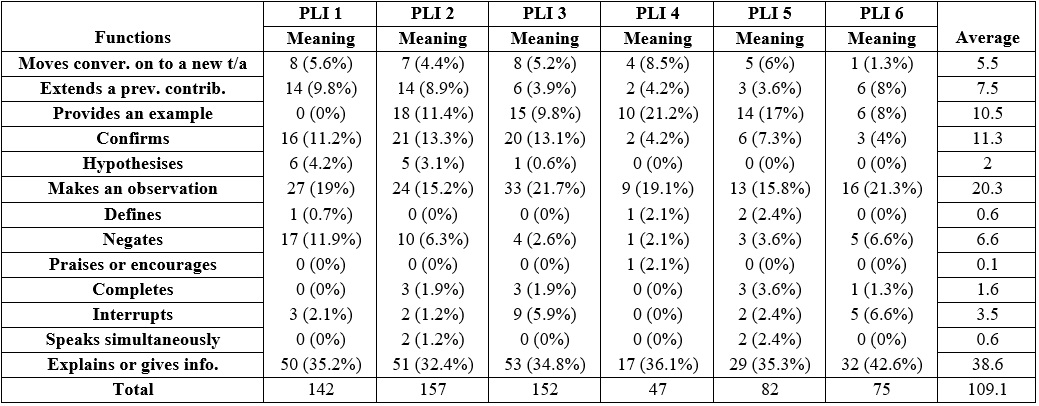
Table 10. Discourse functions in PLIs (advanced level).
As shown in Table 10, the advanced learners’ turns in the PLIs involved a range of 13 out of 17 discourse functions. This again indicates that the opportunity for the advanced learners to utilise a greater number and range of discourse functions was enhanced in the PLIs.
As indicated by the above results, the teachers at the three proficiency levels dominated the number and range of discourse functions during the whole recorded sessions and, interestingly, the TLIs, during which the teachers and learners practised speaking. This can be explained by the teachers’ role in performing the lessons and, in particular, their dominance over the discourse which enabled them to utilise a greater number and range of discourse functions than the learners. These findings support previous research (see Long et al., 1976; Long & Porter, 1985), in that, due to teachers’ and learners’ unequal interactional roles, discourse functions are considerably dominated by teachers.
Nevertheless, the learners across proficiency levels were found to initiate a greater number and range of discourse functions during the PLIs than the TLIs. These findings are consistent with previous research (Cathcart, 1986; DiCamilla & Anton, 1997; Ellis, 2012; House, 1986; Long et al., 1976), which has found that learners utilise a greater number of discourse functions in peer interactions than in teacher-led interactions. For example, Cathcart (1986) reported a study of the use of discourse functions by eight learners in different school settings (inside and outside classrooms, formal and informal interactions). Her findings indicated that the number and range of discourse functions increased in settings where learners were able to initiate the talk, and teachers did not have control of the interactions. Similarly, Long et al. (1976) coded for 44 communicative acts, and compared their quantity and range during teacher-led and peer discussions. Their findings also indicated a greater number and range of communicative acts in peer- rather than teacher-led discussions. Long et al. (1976) and Ellis (2012) assert that the intimacy and inhibition-free environment of PLIs enable learners to utilise discourse functions that are not accessible to them during teacher-led discussions.
Learner talk across proficiency levels also initiated a greater range of discourse functions during the PLIs than the TLIs. At the basic level, the learners in the TLIs mostly initiateddiscourse functions to provide examples, explanations, and information. In the basic PLIs, the learners’ discourse functions were not only to provide examples, explanations and information, but also to extend previous contributions, confirm and negate. At the intermediate level, the learners in the TLIs mostly used discourse functions to provide explanations, information, examples. In the PLIs, the most recurrent discourse functions found in learner talk were to explain, inform, confirm, negate, and make observations.At the advanced level, the learners in the TLIs were found to be mostly defining vocabulary, according to the requirements of the tasks set. In contrast, the learners in the PLIs were found to initiate discourse functions to explain, inform, make observations, confirm, and exemplify. The above findings show that the learners during the TLIs were limited to using discourse functions to explain, inform orexemplify, which can be explained by interactional behaviour adopted following (display) question-and-answer routines. The following extract illustrates how the PLIs typically facilitated the learners with a greater opportunity to utilise a range of discourse functions than the TLIs:
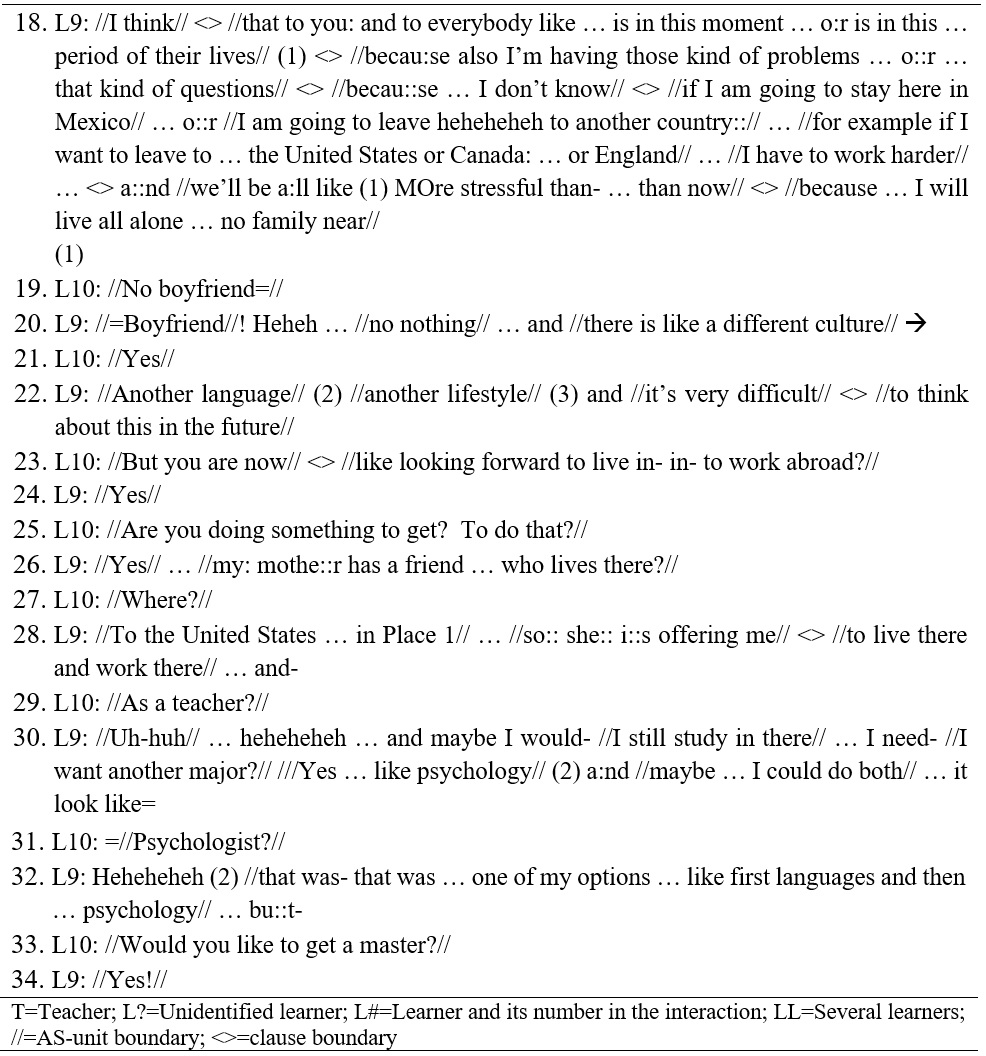
Extract 1. A part of PLI 2 (intermediate level)
In Extract 1, L9 and L10 engage in a discussion about life stages illustrated in some pictures. Due to the absence of the teacher’s dominance, the learners are allocated responsibility over the interaction which encourages them to extend their contributions to share their perceptions (turns 18 and 30), initiate referential questions (turns 23, 25, 27, 29, 31 and 33), and follow up previous contributions (turns 19, 21, 25, 27, 29, and 31). This responsibility over the discourse has an impact on the levels of learners’ fluency and complexity and the use of discourse functions, such as explains or gives information (turns 18, 20, 22, 26, 28, 30 and 32), negates (turn 20), confirms (turns 21, 24, 26, 30 and 34), and the like. In addressing RQ3 (i.e., what pedagogical implications can be learned from RQs 1 and 2 in order to promote learners’ use of discourse functions?), this interactional evidence thus suggests that PLIs for speaking practice promote learners’ use of discourse functions and, possibly, the development of discourse competence. However, the above results in turn reveal the limitations of TLIs as to opportunities for learners to initiate a range of discourse functions and take up discourse roles during speaking practice.
As noted previously, the intermediate learners’ turns involved the greatest number of discourse functions across the recorded sessions and TLIs at the three proficiency levels. The following extract illustrates how the interactional opportunities created by the intermediate teacher allowed the learners to utilise a range of discourse functions, and suggests how teachers may use their interactional strategies during TLIs towards enhancing the interactional space in order to encourage learners’ use of discourse functions:
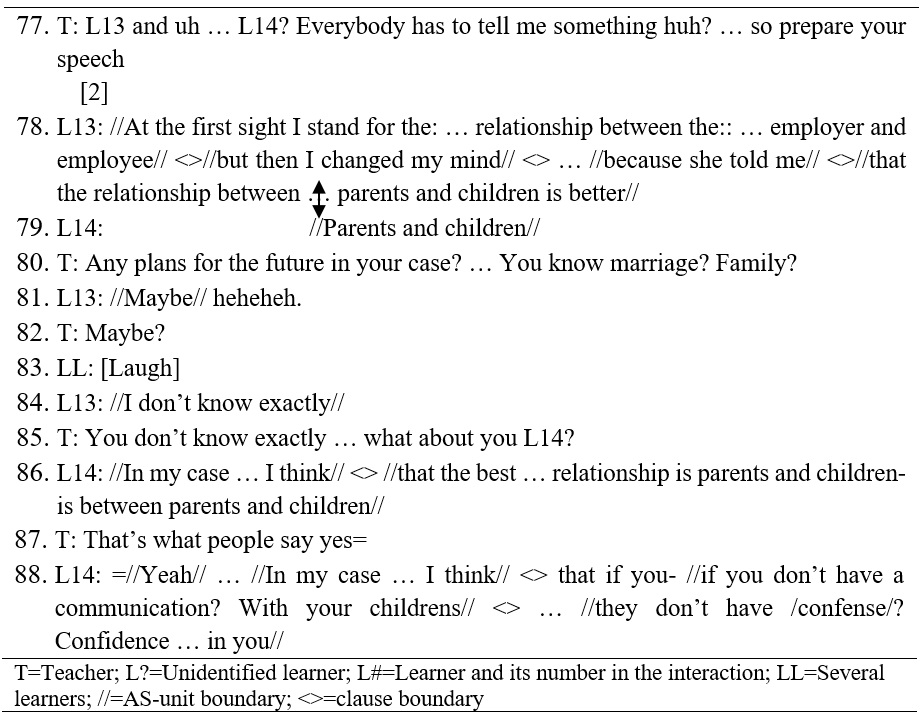
Extract 2. Question-answer patterns at the intermediate level.
In Extract 2, the teacher and learners discuss the importance of relationships between parents and children. It is evident from this extract that the teacher’s intentions were to encourage learners’ oral production by initiating several questions to the same learners (turns 77, 80, 82 and 85) and following up the interaction (turns 82, 85 and 87). As the teacher motivates the learners’ oral production through these interactional strategies, a greater number and range of discourse functions are involved, such as discourse functions to explain (turns 77, 84, 86 and 88), make an observation (line 78), and hypothesise (line 88). What this interactional evidence suggests is that teachers can remain in control of the interaction, yet still use their interactional strategies towards enhancing the interactional space and thus encourage learners to initiate several discourse functions during speaking practice.
Following the above suggestion, the study puts forward the argument that in order to promote TLIs which provide learners with greater opportunities for a number of discourse functions, the teachers need to be assisted in developing an awareness of their interactional behaviour and strategies. To attain this, Walsh (2013) suggests that teachers’ own interactional data, as seen in Extract 2, are useful for directing their reflection practices towards their interactional behaviour, and maximising the interactional space. More importantly, teachers’ own interactional data are claimed to be effective in enabling teachers to ‘notice’ which is related to Walsh’s words (2003), “the first step to describe interactional processes and to make subsequent changes” (p. 15). The suggestion that teachers can use their interactional strategies towards promoting learners’ use of discourse functions is much in line with the notion of scaffolding, which refers to temporary context-sensitive assistancethat teachers provide to learners through collaborative teaching and learning (Walsh, 2013) (e.g., interactional opportunities, speech modifications, teacher modelling, visual material, and hands-on learning, etc.). It is acknowledged that this suggestion requires the teachers’ willingness to record their interactional behaviour and explore it. However, taken together, the findings of this study highlight the importance of teachers directing their teaching-related reflection towards promoting qualitatively better interactions for speaking practice, teachers’ interactional behaviour, and thus learners’ use of discourse functions.
Conclusions
The primary aim of this study was to explore the extent to which classroom interactions at three proficiency levels provided learners with opportunities to initiate discourse functions. The explorations resided in a naturalistic as well as explanatory approach. This involved recording interactions in ongoing EFL courses without controlling classroom conditions, such as teachers’ and learners’ interactional behaviour, number of participants, structure and time of lessons, and tasks.
The findings indicated that the quantity and range of learners’ discourse functions were limited in the recorded sessions and TLIs at the three proficiency levels. Nevertheless, the PLIs, providing greater interactional space and intimacy, promoted a greater number and range of discourse functions than the TLIs. The PLIs also appeared to enable the learners to initiate discourse functions that were frequent in teachers’ discourse (e.g., agree, disagree, confirm, negate, extend contributions, make observations, etc.), suggesting that the quality of learners’ discourse was enhanced in the PLIs, during which learners exerted a greater interactional control. This evidence thus suggests that the PLIs for speaking practice should be promoted, but in turn highlights the need to promote teacher-led communication which allows learners to utilise a range of discourse functions with a view to fostering discourse competence.
Based on the interactional evidence, it seems possible that the number and range of learners’ discourse functions are increased during teacher-led speaking practice if teachers develop an understanding of the classroom interactions and interactional strategies as tools for collaboratively mediating and assisting learning (Walsh, 2006, 2011, 2013). This suggestion raises the need to conduct further research. Firstly, it would be enlightening to know whether data-led reflection has beneficial effects on enhancing the interactional space and thus learners’ use of discourse functions during TLIs. Moreover, there is still need to conduct research which involves a greater number of discourse functions so we can be informed of the discourse functions that tend to be initiated in FL classroom interactions.
In response to Long et al.’s (1976) suggestion to replicate their investigation at basic and advanced proficiency levels using different speaking tasks, the findings of this study confirm that basic and advanced learners not only talked more, but also initiated a wider range of discourse functions during the PLIs than the TLIs, confirming that PLIs promote both the quantity and quality of learners’ discourse.
References
Cathcart, R. (1986). Situational differences and the sampling of young children’s school language. In Day, R. (Ed.), Talking to learn: Conversation in second language acquisition (pp.118-142). Rowley, MA: Newbury House.
Consolo, D. A. (2006). Classroom oral interaction in foreign language lessons and implications for teacher development. Revista Linguagem e Ensino, 9(2), 33-55. Retrieved from: http://www.rle.ucpel.tche.br/index.php/rle/article/view/165x
DiCamilla, F. J. & Anton, M. (1997). Repetition in the collaborative discourse of L2 learners: A Vygotskian perspective. The Canadian Modern Language Review, 53(4), 609-633. Retrieved from: http://eric.ed.gov/?id=EJ549189
Dinçer, A. & Yeşilyurt, S. (2013). Pre-service English teachers' beliefs on speaking skill based on motivational orientations. English Language Teaching, 6(7), 88-95. doi: http://dx.doi.org/10.5539/elt.v6n7p88
Ellis, R. (2012). Language teaching research and language pedagogy. Hoboken, NJ: Wiley-Blackwell.
Foster, P. (1998). A classroom perspective on negotiation of meaning. Applied Linguistics, 19(1), 1–23. doi: 10.1093/applin/19.1.1
Foster, P., Tonkyn, A. & Wigglesworth, G. (2000). Measuring spoken language: A unit for all reasons. Applied Linguistics, 21(3), 354-375. doi: https://doi.org/10.1093/applin/21.3.354
Hatch, E. (1978a). Acquisition of syntax in a second language. In J. Richards (Ed.), Understanding second and foreign language learning (pp. 34-70). Rowley, MA: Newbury House.
Hatch, E. (1978b). Discourse analysis and second language acquisition. In E. Hatch (Ed.), Second language acquisition: A book of readings (pp.401-435). Rowley, MA: Newbury House.
House, J. (1986). Learning to talk: Talking to learn. An investigation of learner performance in two types of discourse. In G. Kasper (Ed.), Learning, teaching and communication in the foreign language classroom (43-57).Aarhus: Aarhus University Press.
Karaata, C. (2011). Assumptions and pedagogical knowledge: Teaching and learning according to teachers of English. Hacettepe University Journal of Education, 41, 244-254. Retrieved from: http://eric.ed.gov/?id=EJ956073
Kumaravadivelu, B. (2001). Toward a postmethod pedagogy. TESOL Quarterly, 35(4), 537-560. doi: 10.2307/3588427
Larsen-Freeman, D. & Long, M. H. (1991). An introduction to second language acquisition research. London, UK: Pearson.
Long, M. H. & Porter, P. A. (1985). Group work, interlanguage talk, and second language acquisition. TESOL Quarterly,19(2), 207-228. doi: 10.2307/3586827
Long, M. H. (1983). Native speaker/non-native speaker conversation and the negotiation of comprehensible input. Applied Linguistics,4(2), 126-141. doi: https://doi.org/10.1093/applin/4.2.126
Long, M. H., Adams, L., McLean, M. & Castaños, F. (1976). Doing things with words: Verbal interaction in lockstep and small group classroom situations. In J. Fanselow & R. Crymes (Eds.), On TESOL ’76 (pp.137-153). Washington, DC: TESOL.
Medgyes, P. (2000). Non-native speaker teacher. In M. Byram (Ed.), Routledge encyclopedia of language teaching and learning (pp. 444-446). London, UK; New York, NY: Routledge.
Petek, T. (2014). The teacher as a public speaker in the classroom. Studies in Literature and Language, 9(1), 124-133. doi: http://dx.doi.org/10.3968/n
Philp, J. & Tognini, R. (2009). Language acquisition in foreign language contexts and the differential benefits of interaction. International Review of Applied Linguistics in Language Teaching, 47(3/4), 245-66. doi: 10.1515/iral.2009.011
Swain, M. (1985). Communicative competence: Some roles of comprehensible input and comprehensible output in its development. In S. Gass & C. Madden (Eds.), Input in second language acquisition (pp. 235-256). New York, NY: Newbury House.
UAEM (2010). Curriculum de la Licenciatura en Lenguas. Toluca: Universidad Autónoma del Estado de México.
Velázquez, V. & García Ponce, E. E. (2016). Foreign language planning in a teacher/translator training programme at a Mexican university. ECORFAN Journal-Czech Republic, 1(1), 1-17. Retrieved from: http://www.ecorfan.org/czechrepublic/journal/ECORFAN%20Journal%20-%20Czech%20Republic%20V1%20N1_1.pdf
Vygotsky, L. S. (1978). Mind and society. Cambridge, MA: Harvard University Press.
Walsh, S. (2002). Construction or obstruction: Teacher talk and learner involvement in the EFL classroom. Language Teaching Research,6(1), 3-23. doi: 10.1191/1362168802lr095oa
Walsh, S. (2006). Investigating classroom discourse. London, UK: Routledge.
Walsh, S. (2011). Exploring classroom discourse: language in action. London, UK: Routledge.
Walsh, S. (2013). Classroom discourse and teacher development. Edinburgh, UK: Edinburgh University Press.
Yoshida, R. (2013). Conflict between learners' beliefs and actions: Speaking in the classroom. Language Awareness,22(4), 371-388. doi: http://dx.doi.org/10.1080/09658416.2012.758129

